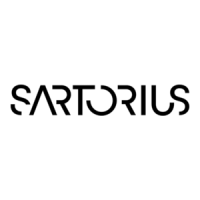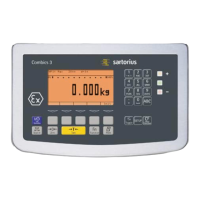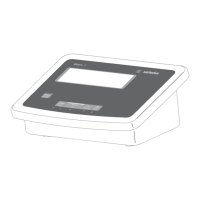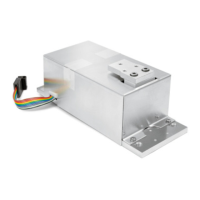51
You can output the value displayed in the measured value line
and the weight unit, with or without a data ID code. Whether
the data ID code is included in the output depends on your
settings under “Line Format”.
Examples:
+ 235 pcs Without data ID code
Qnt + 235 pcs With data ID code
Line Format settings:
For raw data (16 characters): no “data header“
For other apps. 22 characters): with “data header”
(factory setting).
Data Output Format with 16 Characters
Display segments that are not activated are output as spaces.
Characters without a decimal point are output without a
decimal point.
The type of character that can be output depends on the
character’s position:
Normal Operation
Pos. 1 2345678910111213141516
+* DDDDDDDD* UUUCRLF
or - * DDDDDDDD* UUUCRLF
or **************CRLF
+-: Plus or minus sign
*: Space
D: Digit or letter (max. 7 characters plus decimal point)
U: Character for unit of measurement
1
(1 to 3 letters followed by 0 to 2 spaces)
CR: Carriage return
LF: Line feed
1)
depends on scale type; for example, not all units are
available on scales verified for use in legal metrology.
Special Codes
Pos. 1 2345678910111213141516
******––******CRLF
or ******H*******CRLF
or ******HH******CRLF
or ******L*******CRLF
or ******LL******CRLF
or ******C*******CRLF
*: Space
– –: Final readout mode
H: Overload
HH: Overload in Checkweighing
L: Underload
LL: Underload in Checkweighing
C: Calibration/adjustment
Error Codes
Pos. 12345678910111213141516
***Err**##****CRLF
or ***Err*###****CRLF
*: Space
#: Error code number (2 or 3 digits)
Example: Output of the weight value +1255.7 g
Pos. 12345678910111213141516
+* * * 1255. 7* g* * CRLF
Position 1: Plus or minus sign or space
Position 2: Space
Positions 3-10: Weight value with decimal point;
leading zeros are output as spaces.
Position 11: Space
Positions 12-14: Unit symbol or space
Position 15: Carriage return
Position 16: Line feed
Data Output Format with 22 Characters
When data is output with an ID code, the 6-character code
precedes the 16-character string described above. The code
identifies the subsequent value.
Normal Operation
Pos. 1 2 3 4 5 6 7 8 9 10 11 1213 14151617 18 19 20 21 22
IIIIII+*DDDDDDDD*UUUCRLF
or IIIIII-*DDDDDDDD*UUUCRLF
or ********************CRLF
I: ID code character
1
, right-justified with spaces
+-: Plus or minus sign
*: Space
D: Digit or letter (max. 7 characters plus decimal point)
U: Character for unit of measurement
1
(1 to 3 letters followed by 0 to 2 spaces)
CR: Carriage return
LF: Line feed
Special Codes
Pos. 1 2 3 4 5 6 7 8 9 10 11 1213 14151617 18 19 20 21 22
Stat********––******CRLF
or Stat********H*******CRLF
or Stat********HH******CRLF
or Stat********L*******CRLF
or Stat********LL******CRLF
or Stat********C*******CRLF
*: Space – –: Final readout mode
H: Overload HH: Overload in Checkweighing
L: Underload LL: Underload in Checkweighing
C: Calibration/adjustment
Data Output Format (Line Format)

